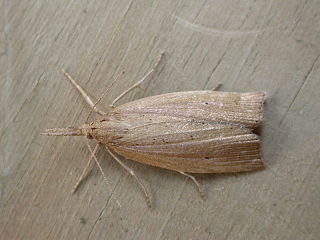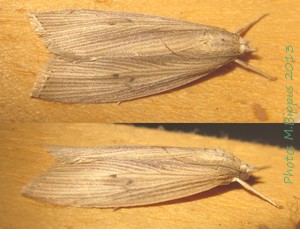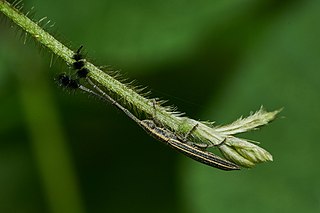
Crambidae comprises the grass moth family of lepidopterans. They are variable in appearance, with the nominal subfamily Crambinae taking up closely folded postures on grass stems where they are inconspicuous, while other subfamilies include brightly coloured and patterned insects that rest in wing-spread attitudes.

Cataclysta lemnata, the small china-mark, is a moth species of the family Crambidae. It is found in Europe, Morocco and Iran.

Chilo phragmitella is a species of moth of the family Crambidae, sometimes referred to by the vernacular names wainscot veneer or reed veneer. It was first described by Jacob Hübner between 1805 and 1810 as Tinea phragmitella, and is the type species of the genus Chilo.

Nomophila noctuella, the rush veneer, is a species of moth of the family Crambidae.

Palpita vitrealis, common name jasmine moth or white pearl, is a species of moth of the family Crambidae.

Udea ferrugalis, the rusty dot pearl, is a moth of the family Crambidae. The species was first described by Jacob Hübner in 1796.

Chilo is a genus of moths of the family Crambidae. Some of these moths are called borers.

Crocidolomia pavonana is a moth of the family Crambidae. Its caterpillar is a crop pest and is known as the croci or the cabbage cluster caterpillar. This moth is found in Africa and Asia, its range extending from South Africa through India to the Pacific Ocean, including Australia. The wingspan is about 25 mm (1 in). The larvae feed on Brassicaceae species and are considered an agricultural pest on cabbages. At first, they feed only on the undersides of the leaves. Later they feed on the rest of the leaves and the central shoot. The species was first described by Johan Christian Fabricius in 1794.

Chilo suppressalis, the Asiatic rice borer or striped rice stemborer, is a moth of the family Crambidae. It is a widespread species, known from Iran, India, Sri Lanka, China, eastern Asia, Japan, Taiwan, Malaysia to the Pacific.

Chilo plejadellus, the rice stalk borer moth, is a moth in the family Crambidae described by Johann Leopold Theodor Friedrich Zincken in 1821. It is found in North America, including Illinois, Ontario, Quebec, Pennsylvania, Georgia, Louisiana, Wisconsin, Texas and Arkansas.

Scirpophaga praelata is a species of moth of the family Crambidae. It is found in most of Europe, Russia, Turkey, Iran, Syria, Lebanon, North Africa, Japan, Taiwan, China and Australia.
Chilo agamemnon is a species of moth in the family Crambidae described by Stanisław Błeszyński in 1962. It is found in Spain, Egypt, Israel, Sudan and Uganda.
Chilo christophi is a species of moth in the family Crambidae described by Stanisław Błeszyński in 1965. It is found in Romania, the southern Ural region, Armenia, Djarkent, Issyk-Kul, Thian-Shan, Kuldja, Amur, Ussuri, northern China and Japan.
Chilo pulverosellus is a species of moth in the family Crambidae described by Émile Louis Ragonot in 1895. It is found across southern Europe, France, as well as in the Levant region, and in the region of Transcaspia.

Chilo sacchariphagus, the spotted borer, is a moth of the family Crambidae. It was described by Wenceslas Bojer in 1856 and was originally found in South and South-East Asia, where there are three subspecies:
Chilo auricilius, the gold-fringed rice stemborer or terai borer, is a moth in the family Crambidae. It was described by Gerald C. Dudgeon in 1905. It is found in India, Taiwan, Bhutan and Sri Lanka, as well as on Sulawesi, Borneo, Sangir Island and the Moluccas. The larvae bore into and feed on the stems of various grass family plants including sugarcane, rice and maize.
Chilo infuscatellus, the yellow top borer or sugarcane shoot borer, is a moth in the family Crambidae. It was described by the Dutch entomologist Samuel Constantinus Snellen van Vollenhoven in 1890. It is found in India, Myanmar, Tajikistan, Afghanistan, Korea, Taiwan, Malaysia, the Philippines and on Java and Timor.
Chilo partellus, the spotted stalk borer or spotted stem borer, is a moth in the family Crambidae. It was described by Charles Swinhoe in 1885. It is found in India, Pakistan, Iran, Ethiopia, Lesotho, Madagascar, Malawi, South Africa, Sudan, Tanzania, Uganda and on Mayotte.
Bissetia steniellus is a moth in the family Crambidae. It was first described by the British entomologist George Hampson in 1899. It is found in India and Vietnam where it is commonly known as the Gurdaspur borer because the larvae bore their way into and feed on the stems of sugarcane.

A stemborer is any insect larva, or arthropod, that bores into plant stems. However the term most frequently refers among the Coleoptera to the larva of certain longhorn beetles such as Dorysthenes buqueti and those of the genus Oberea, and among the Lepidoptera to certain moths of the Crambidae, Castniidae, Gelechiidae, Nolidae, and Pyralidae families.












